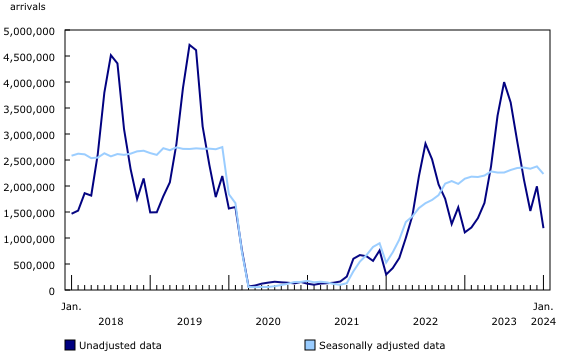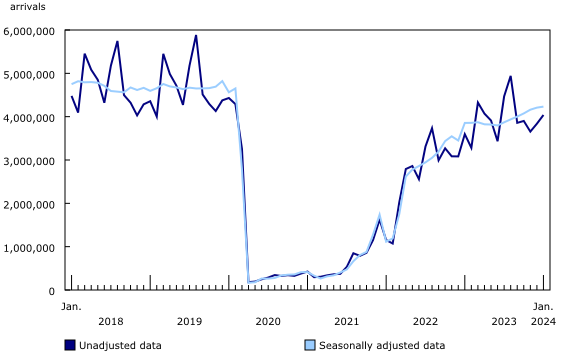Travel between Canada and other countries, January 2024
Released: 2024-03-22
Highlights
In January, the number of non-resident visitors to Canada accounted for 75.9% of the number observed in January 2020, before the COVID-19 pandemic, with US residents taking 910,600 trips to Canada and residents of overseas countries taking 278,700.
During the same period, the number of returning Canadian residents reached 91.2% of the level recorded in January 2020, as Canadian residents returned from 4.0 million trips abroad in January 2024.
For the first time since December 2021, seasonally adjusted figures are available to allow for comparisons with the previous month (see Note to readers). In comparison with December 2023, the number of non-resident arrivals in Canada in January 2024 declined by 6.1%, while the number of returning Canadian-resident arrivals increased by 0.6%.
To further explore current and historical data in an interactive format, please visit the Frontier Counts: Interactive Dashboard.
Trips to Canada by US residents
In January, US residents took 910,600 trips to Canada, up 5.1% from the 866,700 trips taken during the same month in 2023 and reaching 75.8% of the pre-pandemic level observed in January 2020 (1.2 million).
In January 2024, almost three-quarters (72.4%) of US residents visiting Canada arrived by automobile (658,800 arrivals), and over half (58.7%) of those were same-day trips. Arrivals by automobile were up 2.1% from the previous year and represented 76.0% of such trips recorded in January 2020.
Air arrivals (223,600) constituted 24.6% of all trips to Canada made by US residents in January 2024. Those arrivals were 12.8% higher than the same month in 2023 and reached 79.0% of such trips taken in January 2020.
The most frequented points of entry by residents of the United States arriving by automobile in January 2024 were near Vancouver (including Douglas and Pacific Highway in Surrey), in southwestern Ontario (including Windsor and Sarnia), and in Niagara (including Niagara Falls and Fort Erie). Combined, these points of entry represented 68.6% of US-resident arrivals by automobile. The busiest airports for US-resident arrivals by air were in Toronto (including Toronto Pearson International Airport and Billy Bishop Toronto City Airport), Vancouver, Montréal, and Calgary. Combined, these cities were the points of entry for 92.9% of all such trips.
Trips to Canada by overseas residents
In January, 278,700 overseas residents arrived in Canada, an increase of 15.6% from the 241,100 overseas arrivals observed in January 2023 and reaching 76.2% of such arrivals recorded in January 2020 (365,600), before the pandemic. Most (86.7%) of the overseas residents arriving in January 2024 flew into Canada (241,600 arrivals).
Residents of the top three overseas markets for January—Mexico (39,600), the United Kingdom (25,300), and France (22,500)—combined to represent 31.4% of all overseas arrivals in Canada in the month. Mexico ranked as the top overseas market for the third consecutive month.
In January, overseas residents arrived most frequently in Canada at airports located in Toronto, Vancouver, Montréal, and Calgary. Combined, these airports were the entry points for 96.1% of all overseas arrivals by air.
Trips abroad by Canadian residents
Canadian residents returned from 4.0 million trips abroad in January, increasing 12.3% from January 2023 (3.6 million) and reaching 91.2% of such trips taken during the same month in 2020 (4.4 million).
In January 2024, Canadian residents returned by air from 2.2 million trips abroad, which represented more than half (55.0%) of the total trips taken by Canadian residents. The number of air arrivals was 13.4% higher than it was the same month one year earlier and reached 96.6% of such arrivals recorded in January 2020.
Automobile trips to the United States (1.8 million) in January 2024 represented 44.1% of the total trips made by Canadian residents, and almost two-thirds (65.4%) of those were same-day returns. The number of Canadian residents returning by automobile from a visit to the United States increased by 10.8% year over year and represented 86.1% of such trips taken in January 2020.
In January 2024, the busiest airports for arrivals by Canadian residents returning home were in Toronto, Vancouver, Montréal, and Calgary, which, combined, represented 89.5% of all trips from the United States and 85.7% of all trips from overseas countries. The busiest points of entry for Canadian residents returning from the United States by automobile were in southwestern Ontario, near Vancouver, and in Niagara, which represented a combined 62.6% of the points of entry of all trips.
Seasonally adjusted arrivals
Tourism is influenced by seasonal effects (e.g., actual seasons, holidays such as Canada Day, Thanksgiving, and others) and by calendar effects (e.g., number of weekends in a month). For the first time since December 2021, Statistics Canada is presenting seasonally adjusted data on the number of arrivals to Canada. All statistics in this section are based on seasonally adjusted data (for more information, please see Note to readers).
In January 2024, the number of arrivals in Canada by US residents decreased by 6.3% compared with the previous month. While arrivals in Canada by air increased by 2.1%, trips by automobile decreased by 7.2%, which is attributable to fewer same-day automobile trips from the United States (-9.8%).
The number of overseas-resident arrivals in Canada decreased by 5.5% in January compared with December. Arrivals from Europe, the largest overseas market, with 42.5% of total overseas visitors, decreased by 10.9%, as the number of arrivals from the top two European markets, the United Kingdom (-18.1%) and France (-12.3%), declined. In contrast, arrivals in Canada by residents of Asia, the second-largest overseas market, increased by 4.1%.
The 0.6% increase in Canadian residents returning from a trip abroad in January marked the seventh consecutive monthly increase of such trips. The increase from December is mainly attributable to an increase in the number of overnight automobile trips to the United States (+4.2%). During the same period, Canadian residents returning by air from abroad decreased by 0.2%.
Did you know we have a mobile app?
Get timely access to data right at your fingertips by downloading the StatsCAN app, available for free on the App Store and on Google Play.
Note to readers
What is seasonal adjustment? Tourism is influenced by seasonal and calendar effects. These effects can bring about changes in the data that normally occur at the same time, and in about the same magnitude, every year. A seasonally adjusted time series is a time series that has been adjusted to eliminate the effect of seasonal and calendar influences. Seasonally adjusted data allow for more meaningful comparisons of economic conditions from period to period. For information on seasonal adjustment, see Seasonally adjusted data – Frequently asked questions.
Seasonally adjusted data have been produced using the X12 ARIMA seasonal adjustment program.
Seasonally adjusted data for January 2020 to December 2023 have been revised. No revisions were made to unadjusted (raw) data.
Unless otherwise specified, this release uses unadjusted (raw) data.
Readers are encouraged to review the concepts, definitions, data sources, methods, and summary of changes for Frontier Counts, as well as explanatory notes for online tables, especially when making historical comparisons and examining specific regions.
For more current estimates of international arrivals to Canada, please see the "Leading indicator of international arrivals to Canada" for the February 2024 reference month.
For more information on travel by Canadian residents, please see the quarterly release of the National Travel Survey (NTS). For more information on travel in Canada by non-residents, please see the quarterly release of the Visitor Travel Survey (VTS). NTS and VTS data for the first quarter of 2024 will be available on August 28.
Products
The product "Frontier Counts: Interactive Dashboard," part of the Data Visualization Products series (71-607-X), is also available.
Contact information
For more information, or to enquire about the concepts, methods, or data quality of this release, contact us (toll-free 1-800-263-1136; 514-283-8300; infostats@statcan.gc.ca) or Media Relations (statcan.mediahotline-ligneinfomedias.statcan@statcan.gc.ca).
- Date modified:




